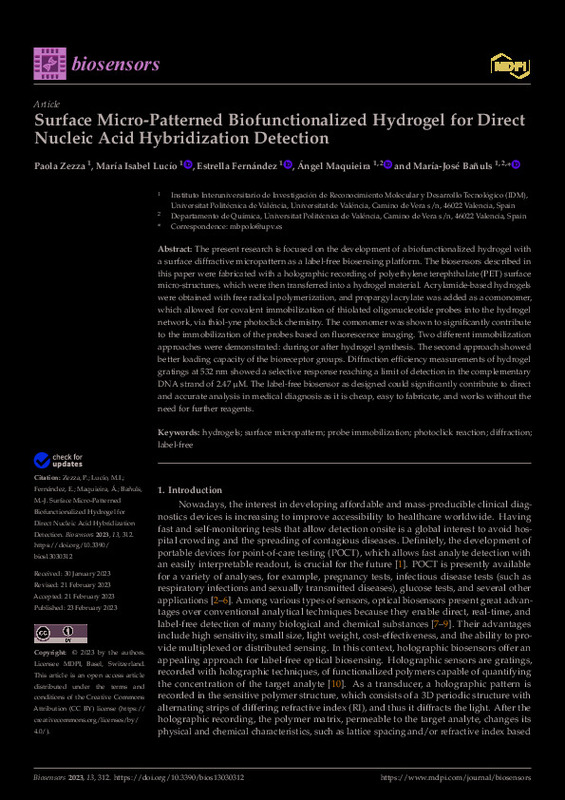JavaScript is disabled for your browser. Some features of this site may not work without it.
Buscar en RiuNet
Listar
Mi cuenta
Estadísticas
Ayuda RiuNet
Admin. UPV
Surface Micro-Patterned Biofunctionalized Hydrogel for Direct Nucleic Acid Hybridization Detection
Mostrar el registro sencillo del ítem
Ficheros en el ítem
| dc.contributor.author | Zezza, Paola
|
es_ES |
| dc.contributor.author | Lucío, María Isabel
|
es_ES |
| dc.contributor.author | Fernández, Estrella
|
es_ES |
| dc.contributor.author | Maquieira Catala, Angel
|
es_ES |
| dc.contributor.author | Bañuls Polo, María-José
|
es_ES |
| dc.date.accessioned | 2024-01-03T19:03:59Z | |
| dc.date.available | 2024-01-03T19:03:59Z | |
| dc.date.issued | 2023-03 | es_ES |
| dc.identifier.issn | 2079-6374 | es_ES |
| dc.identifier.uri | http://hdl.handle.net/10251/201421 | |
| dc.description.abstract | [EN] The present research is focused on the development of a biofunctionalized hydrogel with a surface diffractive micropattern as a label-free biosensing platform. The biosensors described in this paper were fabricated with a holographic recording of polyethylene terephthalate (PET) surface micro-structures, which were then transferred into a hydrogel material. Acrylamide-based hydrogels were obtained with free radical polymerization, and propargyl acrylate was added as a comonomer, which allowed for covalent immobilization of thiolated oligonucleotide probes into the hydrogel network, via thiol-yne photoclick chemistry. The comonomer was shown to significantly contribute to the immobilization of the probes based on fluorescence imaging. Two different immobilization approaches were demonstrated: during or after hydrogel synthesis. The second approach showed better loading capacity of the bioreceptor groups. Diffraction efficiency measurements of hydrogel gratings at 532 nm showed a selective response reaching a limit of detection in the complementary DNA strand of 2.47 mu M. The label-free biosensor as designed could significantly contribute to direct and accurate analysis in medical diagnosis as it is cheap, easy to fabricate, and works without the need for further reagents. | es_ES |
| dc.description.sponsorship | This work was financially supported by the E.U. FEDER, the Spanish Ministry of Science and Innovation (ADBIHOL-PID2019-110713RB-I00/AEI/10.13039/501100011033) and Generalitat Valenciana (PROMETEO/2020/094). M. I. Lucío acknowledges her Juan de la Cierva-Incorporación grant (IJC 2018-035355-I) funded by MCIN/AEI/10.13039/501100011033. P. Zezza acknowledges Generalitat Valenciana for her Grisolia fellowship grant. | es_ES |
| dc.language | Inglés | es_ES |
| dc.publisher | MDPI AG | es_ES |
| dc.relation.ispartof | Biosensors | es_ES |
| dc.rights | Reconocimiento (by) | es_ES |
| dc.subject | Hydrogels | es_ES |
| dc.subject | Surface micropattern | es_ES |
| dc.subject | Probe immobilization | es_ES |
| dc.subject | Photoclick reaction | es_ES |
| dc.subject | Diffraction | es_ES |
| dc.subject | Label-free | es_ES |
| dc.subject.classification | QUIMICA ANALITICA | es_ES |
| dc.title | Surface Micro-Patterned Biofunctionalized Hydrogel for Direct Nucleic Acid Hybridization Detection | es_ES |
| dc.type | Artículo | es_ES |
| dc.identifier.doi | 10.3390/bios13030312 | es_ES |
| dc.relation.projectID | info:eu-repo/grantAgreement/AEI/Plan Estatal de Investigación Científica y Técnica y de Innovación 2017-2020/PID2019-110713RB-I00/ES/HACIA EL BIOSENSADO HOLOGRAFICO AVANZADO/ | es_ES |
| dc.relation.projectID | info:eu-repo/grantAgreement/GENERALITAT VALENCIANA//PROMETEO%2F2020%2F094//HOLOGRAFÍA. UNA VIA PARA AFRONTAR NUEVOS RETOS EN BIOSENSADO/ | es_ES |
| dc.relation.projectID | info:eu-repo/grantAgreement/MINECO//IJC 2018-035355-I/ | es_ES |
| dc.rights.accessRights | Abierto | es_ES |
| dc.contributor.affiliation | Universitat Politècnica de València. Escuela Técnica Superior de Ingeniería Agronómica y del Medio Natural - Escola Tècnica Superior d'Enginyeria Agronòmica i del Medi Natural | es_ES |
| dc.description.bibliographicCitation | Zezza, P.; Lucío, MI.; Fernández, E.; Maquieira Catala, A.; Bañuls Polo, M. (2023). Surface Micro-Patterned Biofunctionalized Hydrogel for Direct Nucleic Acid Hybridization Detection. Biosensors. 13(3). https://doi.org/10.3390/bios13030312 | es_ES |
| dc.description.accrualMethod | S | es_ES |
| dc.relation.publisherversion | https://doi.org/10.3390/bios13030312 | es_ES |
| dc.type.version | info:eu-repo/semantics/publishedVersion | es_ES |
| dc.description.volume | 13 | es_ES |
| dc.description.issue | 3 | es_ES |
| dc.identifier.pmid | 36979524 | es_ES |
| dc.identifier.pmcid | PMC10046352 | es_ES |
| dc.relation.pasarela | S\484104 | es_ES |
| dc.contributor.funder | GENERALITAT VALENCIANA | es_ES |
| dc.contributor.funder | AGENCIA ESTATAL DE INVESTIGACION | es_ES |
| dc.contributor.funder | European Regional Development Fund | es_ES |
| dc.contributor.funder | Ministerio de Economía y Competitividad | es_ES |








